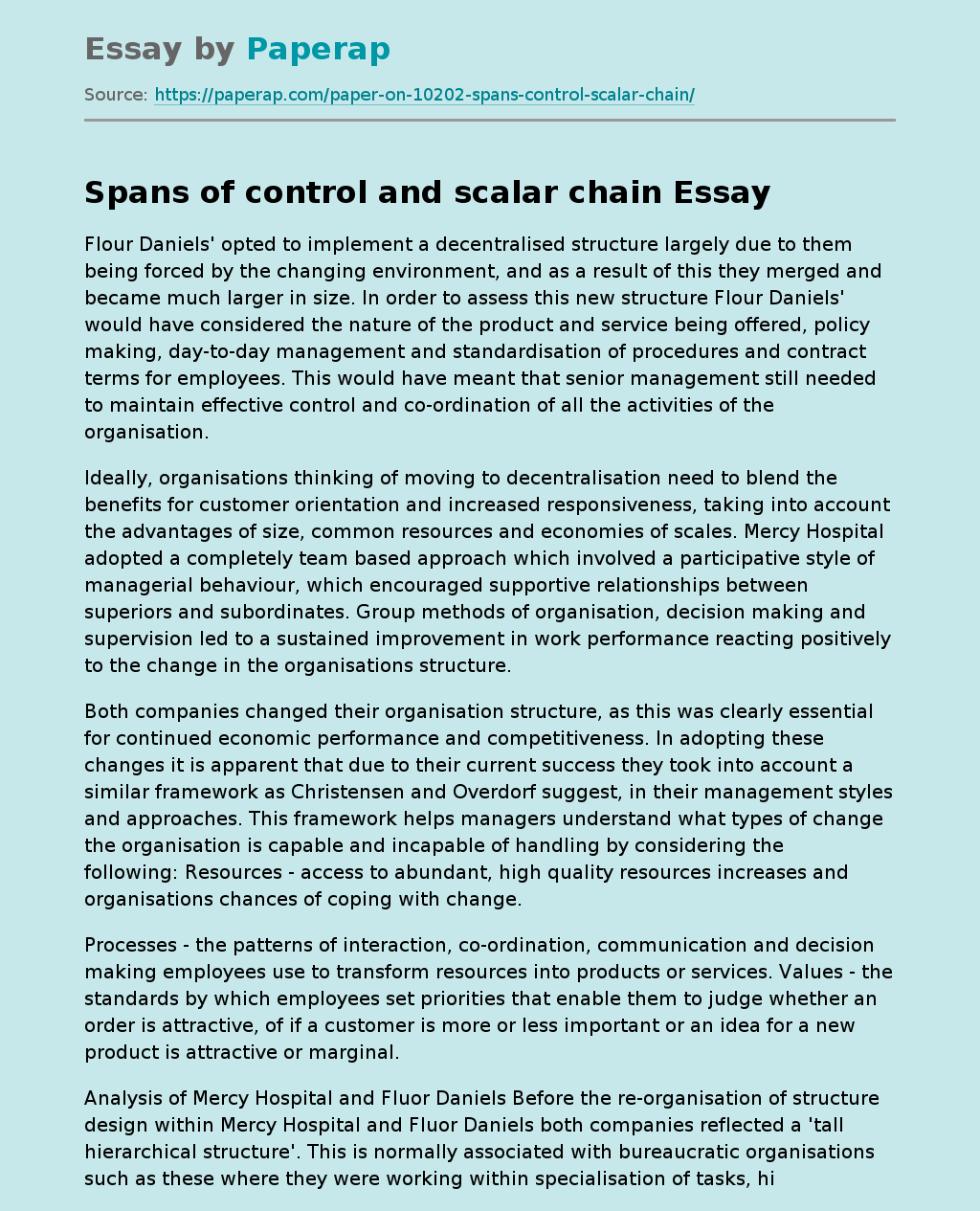Spans of Control and Scalar Chain
Flour Daniels’ opted to implement a decentralised structure largely due to them being forced by the changing environment, and as a result of this they merged and became much larger in size. In order to assess this new structure Flour Daniels’ would have considered the nature of the product and service being offered, policy making, day-to-day management and standardisation of procedures and contract terms for employees. This would have meant that senior management still needed to maintain effective control and co-ordination of all the activities of the organisation.
Ideally, organisations thinking of moving to decentralisation need to blend the benefits for customer orientation and increased responsiveness, taking into account the advantages of size, common resources and economies of scales. Mercy Hospital adopted a completely team based approach which involved a participative style of managerial behaviour, which encouraged supportive relationships between superiors and subordinates. Group methods of organisation, decision making and supervision led to a sustained improvement in work performance reacting positively to the change in the organisations structure.
Both companies changed their organisation structure, as this was clearly essential for continued economic performance and competitiveness. In adopting these changes it is apparent that due to their current success they took into account a similar framework as Christensen and Overdorf suggest, in their management styles and approaches. This framework helps managers understand what types of change the organisation is capable and incapable of handling by considering the following: Resources – access to abundant, high quality resources increases and organisations chances of coping with change.
Processes – the patterns of interaction, co-ordination, communication and decision making employees use to transform resources into products or services. Values – the standards by which employees set priorities that enable them to judge whether an order is attractive, of if a customer is more or less important or an idea for a new product is attractive or marginal. Analysis of Mercy Hospital and Fluor Daniels Before the re-organisation of structure design within Mercy Hospital and Fluor Daniels both companies reflected a ‘tall hierarchical structure’. This is normally associated with bureaucratic organisations such as these where they were working within specialisation of tasks, hierarchy of authority and decision making with systems of rules and regulations, with many layers. This resulted in simple tasks being dealt with inefficiently due to the number of levels of authority in order for a decision to be made.
As Tom Peters suggests there are three key things that must happen to an organisational structure if they are to change quickly to different circumstances. – Layers of management must be radically reduced. No more than five layers are necessary, regardless of the size. – Most ‘support’ staff must be assigned to the operations of the business, reporting to line managers. They should be encouraged to be ‘business team members’ rather than narrow functional specialists.
A radically increased ratio of non-supervisors to supervisors must be established so that there is a wide span of control. The minimum being one supervisor to every 25-75 non-supervisors. Although adopting different approaches as a reaction of change both companies reflect the above suggestions of Tom Peters. Before the reorganisation employee’s had little or no say on how they wish to see the organisation going, with no delegated power of decision making which leads to frustration due to the beauracacy involved.
Today, both companies enable empowerment of individuals allowing them greater freedom, autonomy, and self control over their work as well as responsibility for decision making. This results in the decision making process being speeded up, the release of creative innovative capacities, greater job satisfaction, motivation and commitment as well as their employees gaining a greater sense of achievement from their work.
The movement of tighter and leaner organisations has increased emphasis on the demand of a flexible firm; this is highlighted by economic pressures and rapid developments in information technology. One particular approach to flexible structural design is the concept of a ‘shamrock’ model. Charles Handy describes this as an organisation which possesses several parts which are nevertheless attached to a whole. This could be described as the approach taken by Fluor Daniels’.
Mercy Hospital and Fluor Daniels’ were aware that they needed to improve their efficiency and competitiveness, whilst appreciating the demand for more participative styles of management and greater involvement of staff. This drew their attention to the consideration of looking at their spans of control and scalar chains. Flatter structures, not only has benefits to both companies due to a reduction and savings on managerial costs but also by the image perceived by customers by reducing unnecessary layers of the scalar chain, with fewer levels between the top and base of the hierarchical pyramid.
Mercy Hospital and Fluor Daniels’ observed the conclusion made by Meredith Belbin ‘the pre-eminence of team working in current and future scenarios will inevitably lead to ‘trapezium’ organisations where autonomous work groups or teams are supported by a small number of operational managers, and where strategic decisions are taken by a small group of separate managers in a balanced team’. They both incorporated the classic structure recommended for empowering, whereby their separate organisations are an inverted triangle, drawn to illustrate the role of the board of directors and facilitators in supporting positions rather than authoritative positions.
Both these organisation which are team based do not require managing, it merely requires their managers and supervisors to become skilled people in facilitating, communicating good and bad news, breaking down barriers and providing expert information and knowledge. Drucker stated ‘There are only organisations, each of which has distinct strengths, distinct limitations and specific applications. It has become clear that organisation is not an absolute. It is a tool for making people productive in working together. As such, a given organisation structure fits certain tasks in certain conditions and at certain times’.
Spans of Control and Scalar Chain. (2017, Dec 07). Retrieved from https://paperap.com/paper-on-10202-spans-control-scalar-chain/

